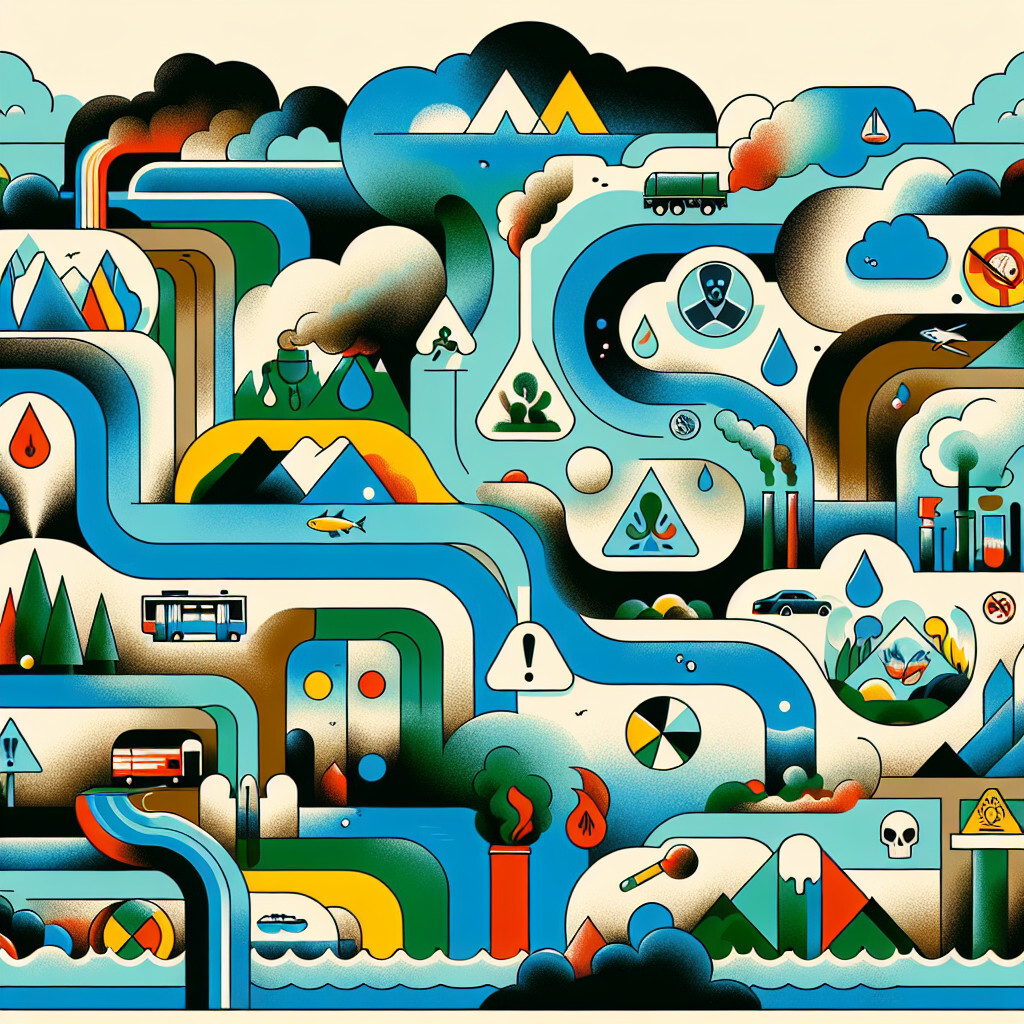-
Table of Contents
“Unmasking the Myths: The Undiluted Truth about Water Pollution”
Introduction

Water pollution is a significant environmental issue that has been the subject of numerous studies and discussions. However, despite the abundance of information available, there are still several myths and misconceptions surrounding this topic. These myths often downplay the severity of water pollution, misrepresent its causes, or mislead about its impacts. They range from the belief that all polluted water is visibly dirty, to the notion that water pollution is only a problem in developing countries. These misconceptions can hinder effective action and policy-making aimed at addressing and mitigating water pollution.
Debunking Common Myths About Ocean Pollution
Ocean pollution, a pressing global issue, is often surrounded by a myriad of misconceptions and myths that can hinder effective solutions. By debunking these common myths, we can better understand the true nature of the problem and work towards more effective, science-based solutions.
One prevalent myth is that the majority of ocean pollution comes from oil spills. While oil spills are indeed disastrous and highly publicized, they account for only a small fraction of total ocean pollution. According to the National Oceanic and Atmospheric Administration, the majority of oil in the ocean comes from natural seeps and routine maintenance of ships, not large-scale spills. Furthermore, oil pollution pales in comparison to the amount of trash, particularly plastic, that enters our oceans each year.
Another common misconception is that most ocean pollution originates from sea-based activities. In reality, about 80% of marine pollution comes from land-based sources, according to the United Nations Environment Programme. This includes runoff from agriculture and industry, untreated sewage, and litter that gets washed into rivers and eventually out to sea. This underscores the importance of managing waste and reducing pollution on land as a key strategy for protecting our oceans.
The third myth is that the ‘Great Pacific Garbage Patch’ is a solid island of trash that can be easily cleaned up. The truth is far more complex. This ‘patch’ is actually a vast area of the Pacific Ocean where currents converge to concentrate marine debris. Much of this debris consists of tiny plastic particles suspended throughout the water column, not a solid mass that can be simply scooped up. Cleaning up these microplastics presents a significant challenge, as they are difficult to remove without also capturing marine life.
The fourth myth is that ocean pollution is only a problem for marine life and coastal communities. In fact, ocean pollution affects us all, no matter where we live. The ocean plays a crucial role in regulating our planet’s climate, absorbing carbon dioxide and helping to mitigate climate change. When pollution disrupts ocean ecosystems, it can impact these vital functions. Moreover, pollutants in the ocean can enter the food chain and eventually make their way onto our plates, posing potential health risks.
Lastly, there is a myth that individual actions cannot make a difference in tackling ocean pollution. This is far from the truth. While it’s true that systemic changes are needed to address this global issue, individual actions can and do add up. Simple steps like reducing plastic use, properly disposing of waste, and supporting policies and companies that prioritize sustainability can collectively make a significant impact.
In conclusion, understanding the realities of ocean pollution is crucial for addressing this global issue effectively. By debunking these common myths, we can dispel misunderstandings, focus on the most impactful solutions, and each play our part in protecting our vital oceans. The task may be monumental, but armed with accurate information, we are better equipped to face the challenge.
The Truth Behind Freshwater Pollution Myths
Water pollution is a pressing global issue that has been the subject of numerous studies, debates, and discussions. Despite the wealth of information available, several myths and misconceptions about water pollution persist, often leading to misguided actions and ineffective solutions. This article aims to debunk some of these myths and shed light on the truth behind freshwater pollution.
One common myth is that all polluted water is visibly dirty. This is far from the truth. While some pollutants do alter the water’s appearance, many harmful substances are invisible to the naked eye. Chemical pollutants such as pesticides, pharmaceuticals, and heavy metals can contaminate water without changing its color or clarity. Therefore, clear water is not necessarily clean water. It is essential to test water quality regularly, especially in areas prone to industrial pollution, to ensure its safety for consumption and use.
Another widespread myth is that water pollution is primarily caused by large industries and corporations. While it is true that industrial activities contribute significantly to water pollution, they are not the sole culprits. Residential areas, agriculture, and even natural processes can also pollute water bodies. For instance, runoff from agricultural fields can carry fertilizers and pesticides into nearby rivers and lakes. Similarly, households contribute to water pollution through the improper disposal of waste and the use of harmful cleaning products. Thus, water pollution is a collective problem that requires everyone’s participation in its solution.
The third myth is that water pollution only affects developing countries. This misconception stems from the visibility of pollution in these regions due to inadequate waste management systems. However, water pollution is a global issue that affects both developed and developing nations. In developed countries, pollutants such as pharmaceuticals, personal care products, and microplastics are often found in freshwater sources. These pollutants pose significant risks to human health and the environment, highlighting the universal nature of water pollution.
The fourth myth is that boiling water makes it safe to drink. While boiling can kill many types of bacteria and viruses, it does not remove chemical pollutants. Consuming water contaminated with heavy metals, pesticides, or other harmful chemicals can lead to serious health problems, even if the water has been boiled. Therefore, it is crucial to use appropriate water treatment methods to ensure the removal of both biological and chemical contaminants.
Lastly, there is a myth that water pollution is an insurmountable problem. This belief can lead to apathy and inaction, exacerbating the issue. However, numerous solutions to water pollution exist, ranging from individual actions to large-scale policy changes. Simple steps such as reducing household waste, using eco-friendly products, and supporting sustainable agriculture can significantly reduce water pollution. On a larger scale, enforcing stricter regulations on industrial pollution and investing in advanced water treatment technologies can also make a substantial difference.
In conclusion, understanding the truth behind these myths is crucial in the fight against water pollution. By dispelling these misconceptions, we can foster a more informed and proactive approach to preserving our precious freshwater resources. After all, clean water is not just a commodity; it is a fundamental human right that we must strive to protect for future generations.
Misconceptions About Industrial Water Pollution
Water pollution, particularly industrial water pollution, is a pressing global issue that has been the subject of numerous studies, debates, and policy-making efforts. Despite the wealth of information available, several misconceptions persist, leading to misunderstandings about the nature, causes, and effects of industrial water pollution. These myths can hinder effective action and policy-making, making it crucial to debunk them and promote a more accurate understanding of the issue.
One common myth is that all industrial activities inevitably lead to water pollution. While it is true that many industries have the potential to pollute water bodies, it is not an inescapable consequence. Many industries have adopted cleaner production methods and waste management systems that significantly reduce or even eliminate their water pollution footprint. For instance, some companies use closed-loop water systems that recycle and reuse water, minimizing waste and pollution. Therefore, it is not accurate to label all industrial activities as inherently polluting.
Another prevalent misconception is that industrial water pollution is solely the responsibility of large corporations. While large industries often contribute significantly to water pollution, small and medium-sized enterprises (SMEs) can also have a substantial impact. In many countries, SMEs make up the majority of businesses and can collectively contribute to a significant portion of industrial water pollution. Their individual contributions may be small, but their cumulative impact can be substantial. Thus, efforts to combat industrial water pollution should not overlook the role of SMEs.
A third myth is that industrial water pollution is only a problem in developing countries. While it is true that industrial pollution is often more visible and severe in these regions due to lax regulations and enforcement, developed countries are not immune. Industries in developed countries can and do contribute to water pollution, often in more subtle and insidious ways. For example, pharmaceutical residues and microplastics from industrial processes are significant pollutants in many developed countries’ water bodies.
The fourth misconception is that industrial water pollution does not affect human health directly. This is a dangerous myth as numerous studies have linked industrial water pollution to a range of health issues, including cancer, neurological disorders, and reproductive health problems. Pollutants such as heavy metals, organic compounds, and endocrine disruptors can contaminate drinking water sources and accumulate in the food chain, posing significant health risks.
Lastly, there is a myth that industrial water pollution is irreversible. While it is true that some effects of water pollution, such as the loss of biodiversity, can be long-lasting, many impacts can be mitigated or reversed with appropriate action. Remediation technologies can clean up polluted water bodies, and stricter regulations can prevent future pollution. Moreover, industries can adopt cleaner technologies and practices, contributing to the solution rather than the problem.
In conclusion, misconceptions about industrial water pollution can hinder our understanding and efforts to address this critical issue. By debunking these myths, we can promote a more accurate understanding of industrial water pollution, its causes, and its effects. This, in turn, can guide more effective policies and actions to protect our precious water resources for future generations.
Busting Myths: The Real Impact of Agricultural Runoff on Water Quality
Water pollution is a pressing global issue that has been the subject of numerous studies, debates, and discussions. One of the most common sources of water pollution is agricultural runoff, which refers to the movement of harmful substances from farms into water bodies. However, there are several myths and misconceptions surrounding the impact of agricultural runoff on water quality. This article aims to debunk these myths and shed light on the real impact of agricultural runoff on water quality.
One prevalent myth is that agricultural runoff is a minor contributor to water pollution. Contrary to this belief, agricultural runoff is a significant source of water pollution. According to the United States Environmental Protection Agency, agricultural runoff is the leading cause of impaired water quality in rivers and lakes. It carries excess nutrients, such as nitrogen and phosphorus, from fertilizers and manure into water bodies. These nutrients can cause harmful algal blooms, which deplete oxygen in the water and harm aquatic life.
Another common myth is that all farmers contribute equally to agricultural runoff. In reality, the impact of farming practices on water quality varies significantly. Some farmers implement sustainable practices that minimize runoff, such as using precision agriculture techniques to apply fertilizers more accurately, planting cover crops to reduce soil erosion, and creating buffer zones around water bodies to filter runoff. However, not all farmers adopt these practices, and those who do not can contribute disproportionately to water pollution.
A third myth is that agricultural runoff only affects rural areas. While it is true that agricultural runoff can have severe impacts on rural water quality, it can also affect urban areas. Runoff can travel long distances through rivers and groundwater, impacting water quality far from its source. Moreover, the nutrients in agricultural runoff can contribute to dead zones in coastal areas, which are areas of water so depleted of oxygen that they cannot support most marine life.
The final myth to be debunked is that there is nothing we can do to reduce the impact of agricultural runoff on water quality. On the contrary, there are many strategies that can be employed to mitigate this issue. For instance, farmers can adopt more sustainable farming practices, as mentioned earlier. Policymakers can also play a role by implementing regulations that limit the amount of nutrients that can be applied to farmland and by providing incentives for farmers to adopt sustainable practices.
In conclusion, it is crucial to dispel these myths about agricultural runoff and water pollution. Recognizing the significant impact of agricultural runoff on water quality, understanding that farming practices vary widely in their environmental impact, acknowledging that agricultural runoff affects both rural and urban water quality, and realizing that there are effective strategies for reducing agricultural runoff are all essential for addressing this critical issue. By debunking these myths, we can foster a more accurate understanding of water pollution and promote more sustainable agricultural practices.
Q&A
Question 1: Is it true that water pollution only affects underdeveloped countries?
Answer: No, this is a myth. Water pollution affects all countries, regardless of their level of development. Industrialized nations also face significant water pollution challenges.
Question 2: Is it true that all polluted water is visibly dirty?
Answer: No, this is a myth. Not all polluted water is visibly dirty. Some contaminants are microscopic and cannot be seen with the naked eye.
Question 3: Is it true that boiling water removes all types of pollutants?
Answer: No, this is a myth. Boiling water can kill bacteria and other pathogens, but it does not remove chemical pollutants or heavy metals.
Question 4: Is it true that the ocean is so big that it can naturally cleanse itself of pollution?
Answer: No, this is a myth. While the ocean has some capacity to dilute certain types of pollution, it cannot fully cleanse itself of all pollutants, especially at the rate at which they are currently being introduced.
Conclusion
In conclusion, myths about water pollution often mislead people, causing misunderstanding and complacency. These include misconceptions that water pollution only occurs in developing countries, that it doesn’t affect humans directly, or that all polluted water is visibly dirty. It’s crucial to debunk these myths to promote accurate knowledge and effective action towards water pollution prevention and mitigation.






